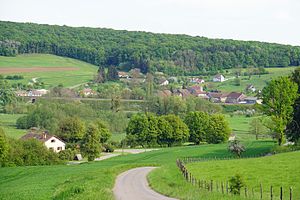La Creuse
| La Creuse | ||
|---|---|---|
|
|
||
| region | Bourgogne-Franche-Comté | |
| Department | Haute-Saône | |
| Arrondissement | Lure | |
| Canton | Lure-1 | |
| Community association | Triangle Vert | |
| Coordinates | 47 ° 41 ′ N , 6 ° 21 ′ E | |
| height | 284-412 m | |
| surface | 5.04 km 2 | |
| Residents | 74 (January 1, 2017) | |
| Population density | 15 inhabitants / km 2 | |
| Post Code | 70240 | |
| INSEE code | 70186 | |
 View of La Creuse |
||
La Creuse is a commune in the French department of Haute-Saône in the region Bourgogne Franche-Comté .
geography
La Creuse is located at an altitude of 300 m above sea level, six kilometers east-southeast of Saulx and about 15 kilometers east-northeast of the city of Vesoul (as the crow flies). The village extends in the central part of the department, in the valley of the Colombine , between the heights of the Bois de Vaugirard and the Bois de Venet .
The area of the municipality of 5.04 km² covers a section in the undulating landscape between the basin of Saulx in the west and the plain of Lure in the east. From east to west the area is crossed by the alluvial lowland of the Colombine, which provides drainage to the Durgeon . The valley is at an average of 290 m and is a maximum of one kilometer wide. Agricultural use prevails here.
The valley is flanked on both sides by relatively steep slopes that lead to the adjacent wooded heights: in the south the Escloupe (355 m), in the southeast the Bois de Venet (up to 390 m), in the east the Grand Bois Communal (368 m) ) and on the opposite side of the valley in the northwest of the Bois de Vaugirard . At 412 m, the highest elevation of La Creuse is reached on this plateau. From a geological and tectonic point of view, the terrain consists of alternating layers of sandy-marl and calcareous sediments that were deposited during the Lias ( Lower Jurassic ). In some places, shell limestone from the Middle Triassic also emerges.
Neighboring municipalities of La Creuse are Adelans-et-le-Val-de-Bithaine in the north, Genevreuille in the east, Pomoy in the south and Velleminfroy and Châtenois in the west.
history
The place name is derived from the old French word cruèse (gorge, narrow valley). In the Middle Ages, La Creuse belonged to the Free County of Burgundy and in it to the area of the Bailliage d'Amont . Local rule was held by the Lords of Faucogney, who left the area to the Bithaine monastery. Its monks made the land arable and founded a dairy farm (Grange de la Creuse), which was the origin of the settlement. Together with Franche-Comté , La Creuse finally came to France with the Peace of Nijmegen in 1678. Today La Creuse is a member of the community association Communauté de communes du Pays de Saulx, which comprises 17 localities .
Attractions
The Fontaine-Lavoir dates from the 19th century.
population
| Population development | |
|---|---|
| year | Residents |
| 1962 | 59 |
| 1968 | 51 |
| 1975 | 50 |
| 1982 | 41 |
| 1990 | 43 |
| 1999 | 51 |
| 2006 | 68 |
With 74 inhabitants (January 1, 2017), La Creuse is one of the smallest municipalities in the Haute-Saône department. After the population had decreased significantly in the first half of the 20th century (203 people were counted in 1886), only slight fluctuations have been recorded since the early 1960s. The population has increased again in recent years.
Economy and Infrastructure
La Creuse is still today a village dominated by agriculture (arable farming, fruit growing and cattle breeding) and forestry. Outside of the primary sector there are few jobs in town. Some workers are therefore commuters who work in the larger towns in the area and in the Vesoul agglomeration.
The village is located off the major thoroughfares on a department road that leads from Pomoy to La Chapelle-lès-Luxeuil . Another road connection exists with Velleminfroy. The railway line from Belfort to Vesoul runs through the municipality . The nearest train station is in Creveney .
